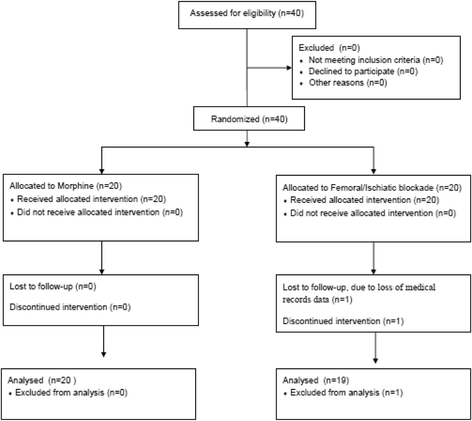Continuous femoral nerve blockade and single-shot sciatic nerve block promotes better analgesia and lower bleeding for total knee arthroplasty compared to intrathecal morphine: a randomized trial
- PMID: 28499420
- PMCID: PMC5429542
- DOI: 10.1186/s12871-017-0355-x
Continuous femoral nerve blockade and single-shot sciatic nerve block promotes better analgesia and lower bleeding for total knee arthroplasty compared to intrathecal morphine: a randomized trial
Abstract
Background: Knee arthroplasty leads to postoperative pain. This study compares analgesia and postoperative bleeding achieved by intrathecal morphine with a continuous femoral plus single-shot sciatic nerve block.
Methods: A randomized non-blinded clinical trial enrolled patients aged over 18 years old, ASA I to III who underwent total knee arthroplasty. All patients underwent spinal anesthesia with isobaric bupivacaine, 20 mg. One group received 100 mcg of intrathecal morphine (M group), and the other received a femoral nerve block by continuous infusion plus a "single shot" block of the sciatic nerve at the end of the surgery (FI group). Pain score from verbal numeric rating scale (VNRS) and morphine consumption during the first 72 h, as well as motor blockade, adverse effects, and postoperative bleeding were recorded. Analysis of variance of repeated measures with Bonferroni post-test, t-test and Fisher exact test were used for statistical analysis.
Results: Thirty nine patients completed the study (M = 20; FI = 19 patients) and were similar except for higher age in the FI group. Motor blockade as well as movement pain during postanesthesia care unit (PACU) staying were not different between the groups, but movement pain was significantly lower in FI group after 24 h. Postoperative bleeding (ml) was lower in FI group.
Conclusions: Continuous femoral nerve block combined with sciatic nerve block provides effective for postoperative analgesia in patients undergoing total knee arthroplasty, with lower pain scores after 24 h and a lower incidence of adverse effects and bleeding compared to intrathecal morphine.
Trial registration: Retrospectively registered on https://clinicaltrials.gov/ under identifier NCT02882152 , 23rd December, 2016.
Keywords: Analgesia; Anesthesia; Arthroplasty; Conduction; Knee; Nerve Block; Pain; Postoperative; Replacement.
Figures
Similar articles
-
Post-operative analgesia following total knee arthroplasty: comparison of low-dose intrathecal morphine and single-shot ultrasound-guided femoral nerve block: a randomized, single blinded, controlled study.Eur Rev Med Pharmacol Sci. 2010 Jul;14(7):589-96. Eur Rev Med Pharmacol Sci. 2010. PMID: 20707248 Clinical Trial.
-
Comparison of continuous femoral nerve block (CFNB/SA) and continuous femoral nerve block with mini-dose spinal morphine (CFNB/SAMO) for postoperative analgesia after total knee arthroplasty (TKA): a randomized controlled study.BMC Anesthesiol. 2016 Jul 16;16(1):38. doi: 10.1186/s12871-016-0205-2. BMC Anesthesiol. 2016. PMID: 27422406 Free PMC article. Clinical Trial.
-
Effects of single shot femoral nerve block combined with intrathecal morphine for postoperative analgesia: a randomized, controlled, dose-ranging study after total knee arthroplasty.J Med Assoc Thai. 2014 Feb;97(2):195-202. J Med Assoc Thai. 2014. PMID: 24765899 Clinical Trial.
-
Is sciatic nerve block advantageous when combined with femoral nerve block for postoperative analgesia following total knee arthroplasty? a meta-analysis.Can J Anaesth. 2016 May;63(5):552-68. doi: 10.1007/s12630-016-0613-2. Epub 2016 Feb 19. Can J Anaesth. 2016. PMID: 26896282 Review.
-
The role of sciatic nerve block to complement femoral nerve block in total knee arthroplasty: a meta-analysis of randomized controlled trials.J Anesth. 2018 Jun;32(3):341-350. doi: 10.1007/s00540-018-2480-1. Epub 2018 Mar 8. J Anesth. 2018. PMID: 29520522
Cited by
-
Continuous femoral nerve block as pain management following total knee arthroplasty: a systematic review.Arch Orthop Trauma Surg. 2025 Apr 11;145(1):238. doi: 10.1007/s00402-025-05855-3. Arch Orthop Trauma Surg. 2025. PMID: 40214694
-
The use of intrathecal morphine in non-abdominal surgery: a scoping review.BJA Open. 2025 Mar 20;14:100387. doi: 10.1016/j.bjao.2025.100387. eCollection 2025 Jun. BJA Open. 2025. PMID: 40223919 Free PMC article. Review.
-
Post-operative analgesia techniques after total knee arthroplasty: A narrative review.Saudi J Anaesth. 2020 Jan-Mar;14(1):85-90. doi: 10.4103/sja.SJA_494_19. Epub 2020 Jan 6. Saudi J Anaesth. 2020. PMID: 31998025 Free PMC article. Review.
References
Publication types
MeSH terms
Substances
Associated data
LinkOut - more resources
Full Text Sources
Other Literature Sources
Medical
Miscellaneous


